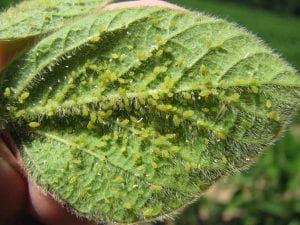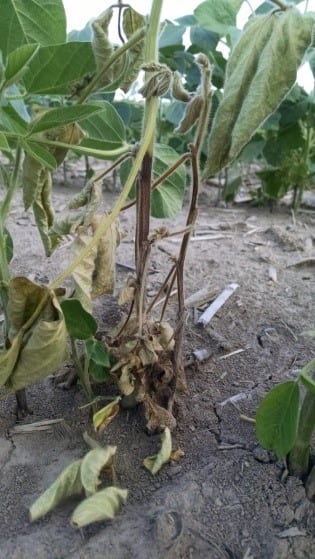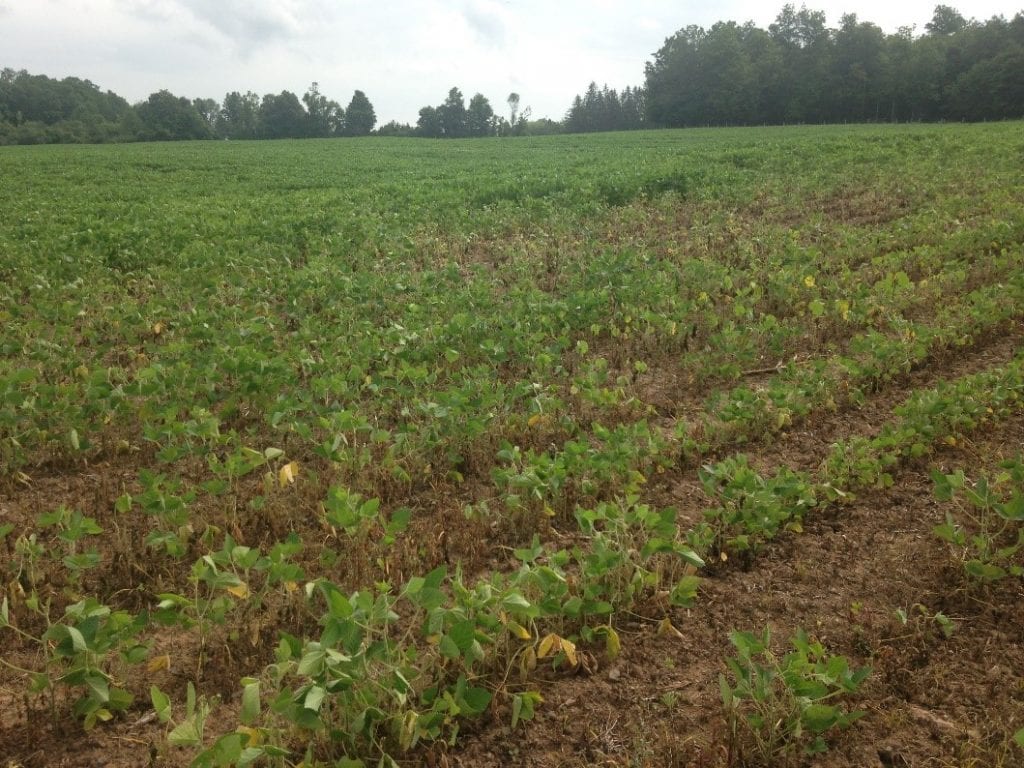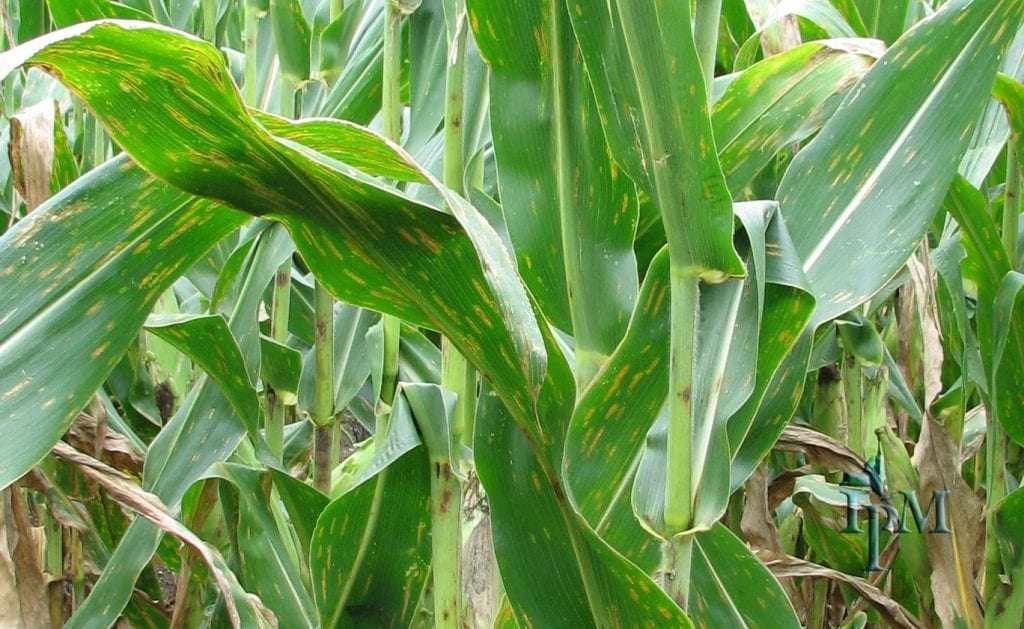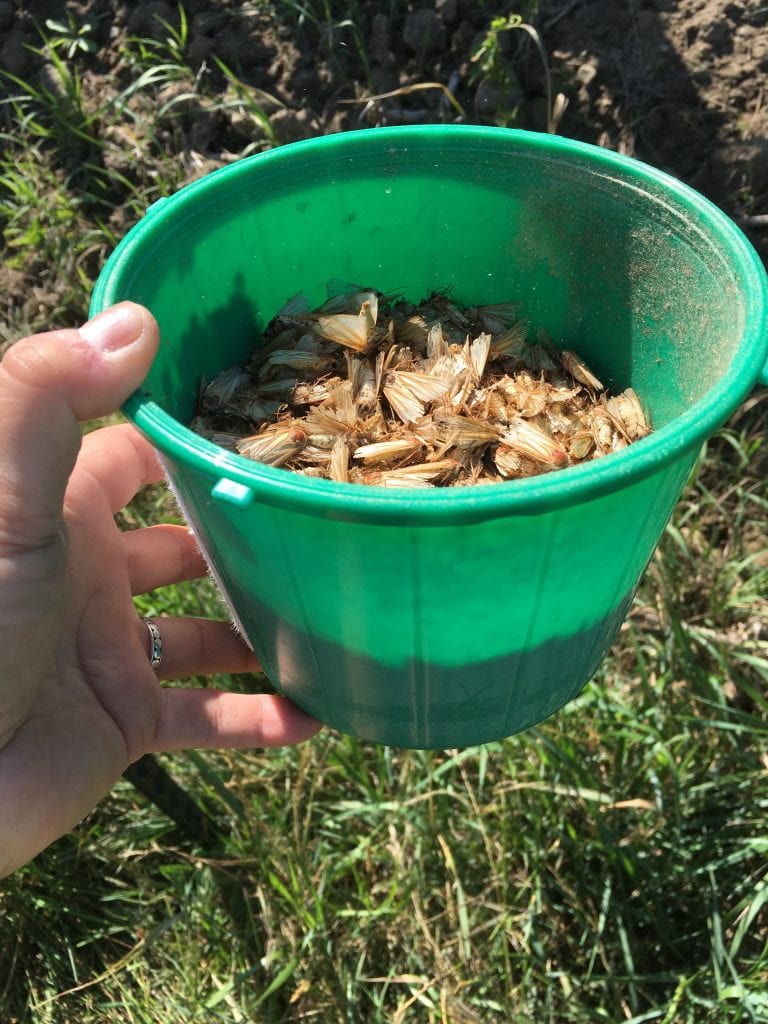Contents
View from the Field
Soybean Aphids (Aphis glycines)
Soybean aphid populations have increased and several soybean fields across the state are at or above the 250 aphid/plant threshold between the R1 and R5 stages of growth. There are also many natural enemies like lady beetles, lacewing larvae (aka antlions), big eye bugs, predatory stinkbugs and more. If a field reaches threshold go back and check the field 2 to 3 days later, and determine if the population is increasing, decreasing or staying about the same. If the field increases with the number of aphids, a spray would be likely if the variety is not resistant. Many times the natural enemies can hold a population under the threshold.
Potato Leafhopper (Empoasca fabae)
There are continued reports of potato leafhopper (Empoasca fabae) (PLH) potato leafhopper over threshold in several fields across NY. For information on scouting/monitoring PLH in alfalfa, view the following video or article:
IPM for potato leafhopper in alfalfa-Video
Time to Scout for Potato Leafhopper in Alfalfa
Phytophthora Root and Stem Rot of Soybean
By Jaime Cumming-NYS IPM
Jeff Miller CCE Oneida County reports phytophthora root and stem rot in a soybean field. Phytophthora root and stem rot, caused by Phytophthora sojae is a complicated soilborne disease of economic concern in soybean production areas of NY. It has been confirmed in at least nine counties in NY, and it is likely more widespread throughout the state. As with most of the soilborne diseases, occurrence depends on favorable conditions, including cool and wet conditions and compacted soils at planting time. The disease is exacerbated by flooding of fields after seeding has occurred. The 2018 growing season has been ideal for this disease in some parts of the state, given our prolonged wet spring and recent heavy rain events causing saturation in some fields. The pathogen survives long-term in the soil as hardy oospores. These oospores germinate to produce sporangia that release the swimming zoospores which infect the soybean roots or are splashed up into the canopy. Infection of seedlings often results in damping off. Symptoms of infection of older plants include lesions beginning at the soil line and extending up the stem, yellow/chlorotic leaves, wilting, reduced vigor, reduction in root mass and death. Over 70 races of this pathogen exist, making management with resistant varieties challenging without knowing which races occur in a particular field. However, varieties with partial resistance (also called field tolerance), which adds some level of protection against all races, are available. Improving soil drainage, reducing compaction, utilizing seed treatments, genetic resistance, and crop rotation are good tools for managing Phytophthora root and stem rot.
Gray Leafspot (Cercospora zeae-maydis)
Kevin Ganoe (CCE Central NY) reports several farms with gray leaf spot (Cercospora zeae-maydis) on corn. Several of the growers decided to spray a fungicide for the disease.
Early symptoms are yellow to tan lesions with a faint watery halo. As the lesion progresses, it turns brown and is rectangular, between the veins. When fully developed the lesion can be 3 to 4 inches long and a 1/6 to 1/8 inch wide. The fungus can overwinter on corn debris left on the soil surface. Sporulation occurs during warm and humid weather in late spring. The spores can be transmitted by both wind and rain. In some cases, gray leaf spot can reduce corn yields from 5 to 40 bushels per acre.
Here are a few steps to follow when making a decision to use a fungicide:
- Scout fields for the gray leaf at tasseling. If there are lesions on leaves at or above the corn ear exceeding 5% of the plant leaf area consider a fungicide. If lesions develop later after tasseling, then economic benefits from using a fungicide will be less.
- Does your hybrid have at least moderate resistance? This can make a big difference in yield and likely will not require a fungicide application. Disease symptoms may be present in resistant corn, but a fungicide most likely will not increase yield.
- Crop rotation and tillage is an effective method to control the fungi. The longer the rotation the less inoculum will be on the surface. If you maintain no-tillage, zone-tillage or reduced tillage rotating away from corn for 2 years can help reduce pathogen populations.
- Fungicides can be very effective when disease exists above the economic threshold. However, fungicides are protective not curative, so applications need to be made before the full extent of disease damage is known. It is generally not economical to spray fungicide on silage corn.
2-spotted spider mites
Mike Stanyard reports spider mites are reaching levels that are causing damage to soybeans. In some parts of the state are still under very dry conditions. Spider mites in soybean occur when there are drought conditions in the field. Two-spotted spider mites can commonly be found in soybeans, but they become problematic under severe drought conditions in the field. Two-Spotted Spider Mites are not insects. They are more closely related to spiders, and they are VERY tiny… less than 0.002 inches long. They look like a speck of dust on the plant to the naked eye. To really see them well you will need a 30+ hand lens or a dissecting scope. The anticipated rain in the forecast for much of the state should help reduce two-spotted spider mites in soybeans
Western Bean Cutworm
Moth captures went up dramatically this week. We caught 14327 moths in 64 traps near field corn. This was an average of 224 moths per trap. Last week we caught 4602 moths caught with an average of 68 per trap. Kitty O’Neil (CCE Northern NY) caught 1400 in one trap this week.
Photo by Kitty O’Neil
Make sure you get out and scout fields at pre-tassel into pollination for WBC eggs and small larvae. See statewide data below:
Weather Outlook – August 2, 2018
Jessica Spaccio
NOAA Northeast Regional Climate Center, Cornell University
Last week temperatures were 2 degrees below-normal to 4 degrees above-normal. Precipitation has ranged from less than ¼” to near 3”. Base 50 growing degree-days ranged from 110-160. Moderate drought expanded in part of northern NY; conditions improved in much of the lower half of the state.
Humid conditions with showers and thunderstorms through the end of the week, dryer over the weekend but heat and humidity continue.
Today temperatures will be in the upper 70s and 80s with high humidity, showers and thunderstorms. There is a possibility of severe weather for some areas (damaging winds, locally heavy rain, hail, isolated tornado). Overnight lows will be in the 60s to low 70s.
Friday highs will be in the mid 70s to mid 80s with high humidity, showers and thunderstorms. The threat of flooding continues for areas that receive heavy rainfall. Overnight temperatures will be in the 60s to low 70s.
Saturday temperatures will be in the upper 70s to mid 80s , showers and thunderstorms will come to an end, western NY will be mostly dry. Overnight temperatures will be in the mid 50s to low 60s.
Sunday highs will be in the upper 70s to upper 80s with mostly dry conditions, an isolated afternoon shower or thunderstorm is possible. Overnight temperatures will be in the low to mid 60s.
Monday temperatures will be hot, in the 80s to low 90s with a slight chance of a showers or thunderstorm and continued humid conditions. Heat indices could reach mid 90s in some areas, watch for heat advisories. Overnight temperatures will be in the 60s.
Tuesday highs will be in the 80s to low 90s with high humidity, showers likely, and thunderstorms possible with the passage of a cold front. Overnight temperatures will be in the 60s.
Wednesday highs will be in the 80s with high humidity and lingering showers. Overnight temperatures will be in the 60s.
The seven-day precipitation amounts will range from three quarters of an inch to three inches.
The 8-14 day outlook (Aug 9-15) favors above-normal temperatures for all of the state and slightly favors above-normal precipitation for most of the state, excluding part of southeast NY.
National Weather Service watch/warnings map
Western Bean Cutworm Update 8.3.17
| Town | 6/24/2018 | 7/1/2018 | 7/8/2018 | 7/15/2018 | 7/22/2018 | 7/29/2018 |
| Aurora | 0 | 1 | 7 | 9 | 22 | 40 |
| Chazy | 0 | 0 | 0 | 2 | 9 | 140 |
| Peru | 0 | 0 | 0 | 1 | 70 | 404 |
| Beekmantown | 0 | 0 | 0 | 0 | 5 | 408 |
| Chazy | 0 | 0 | 0 | 1 | 3 | 514 |
| Champlain | 0 | 0 | 0 | 0 | 3 | 180 |
| Mooers | 0 | 0 | 0 | 0 | 17 | 178 |
| Ellenburgh | 0 | 0 | 0 | 1 | 8 | |
| Kinderhook | 1 | 2 | 8 | 4 | 24 | 18 |
| Homer | 0 | 4 | 50 | 101 | ||
| Preble | 0 | 0 | 1 | 6 | 30 | 42 |
| Walton | 0 | 1 | 7 | 9 | 76 | 35 |
| Walton | 1 | 6 | 49 | 17 | 30 | |
| Amenia | 0 | 0 | 0 | 1 | 12 | 41 |
| Willsboro | 0 | 0 | 0 | 4 | 17 | 16 |
| Willsboro | 0 | 12 | 75 | 52 | ||
| Westport | 0 | 0 | 82 | 150 | ||
| Moira | 1 | 1 | 0 | 1 | 298 | 760 |
| Westville | 0 | 0 | 6 | 80 | 710 | |
| Chateaugay | 0 | 0 | 0 | 19 | 290 | |
| Malone | 0 | 0 | 0 | 3 | 350 | |
| Bombay | 0 | 0 | 1 | 136 | 372 | |
| West Bangor | 0 | 0 | 0 | 103 | 745 | |
| Salisbury | 0 | 0 | 0 | |||
| Calcium | 0 | 0 | 0 | 25 | 229 | |
| Clayton | 0 | 0 | 0 | 13 | 38 | |
| Ellisburg | 0 | 1 | 0 | 342 | 59 | |
| Hounsfield | 0 | 0 | 15 | 214 | 429 | |
| Pamelia | 0 | 1 | 1 | 36 | 146 | |
| Philadelphia | 1 | 0 | 1 | 40 | 103 | |
| Plessis | 0 | 0 | 1 | 36 | 55 | |
| Rutland | 0 | 0 | 1 | 21 | 203 | |
| Watertown | 0 | 0 | 0 | 8 | 65 | |
| Ellisburg | 0 | 0 | 0 | 4 | 221 | 569 |
| Croghan | 0 | 0 | 0 | 193 | 288 | |
| Denmark | 0 | 1 | 0 | 48 | 636 | |
| Harrisburg | 2 | 1 | 0 | 10 | 401 | |
| Lowville | 0 | 0 | 1 | 43 | 341 | |
| New Bremen | 0 | 0 | 0 | 138 | 205 | |
| Turin | 0 | 0 | 0 | 167 | 431 | |
| Martinsburg | 0 | 0 | 0 | 0 | 48 | 587 |
| Avon | ||||||
| Smithville | 0 | 0 | 0 | 0 | 5 | |
| Hamlin | 20 | 80 | 377 | |||
| Hamlin | 0 | 5 | 100 | |||
| Middlebury | 0 | 0 | 0 | 0 | 5 | |
| Glen | 0 | 0 | 0 | 0 | ||
| Palatine | 3 | 0 | 10 | |||
| Barker | 0 | 1 | 42 | 206 | ||
| Cassville | 0 | 1 | 0 | 1 | 41 | 59 |
| munnsville | 0 | 1 | 0 | 0 | 41 | 179 |
| Taberg | 0 | 0 | 8 | 95 | 164 | 204 |
| Westmoreland | 0 | 0 | 0 | 0 | 86 | 1 |
| Memphis | 0 | 0 | 0 | 68 | 86 | 46 |
| Preble | 0 | 1 | 50 | 45 | ||
| Hopewell | ||||||
| Canandaigua | 0 | 21 | 37 | |||
| Albion | 43 | 138 | ||||
| Cherry Valley | 0 | 0 | 0 | 2 | ||
| Auburn | 0 | 0 | 0 | 40 | 70 | 10 |
| Colton | 0 | 9 | 62 | 70 | ||
| Edwards | 0 | 0 | 14 | 206 | ||
| Hammond | 0 | 0 | 11 | 267 | ||
| Huevelton | 0 | 0 | 46 | 132 | ||
| Lawrence | 0 | 38 | 362 | 1400 | ||
| Madrid | 0 | 0 | 82 | 176 | ||
| Massena | 0 | 2 | 14 | 22 | ||
| Waddington | 0 | 0 | 66 | 64 | ||
| Gansevoort | 0 | 0 | 0 | 0 | 87 | 75 |
| Wilton | 0 | 0 | 0 | 0 | 22 | 29 |
| Moreau | 0 | 0 | 1 | 147 | 171 | 178 |
| Riverhead | 0 | 0 | 0 | 0 | 1 | 0 |
| Walworth | 0 | 1 | 4 | 15 | ||
| Easton | 0 | 0 | 1 | 37 | 64 | 30 |
| Castile | 3 | 25 | ||||
| 6/24/2018 | 7/1/2018 | 7/8/2018 | 7/15/2018 | 7/22/2018 | 7/29/2018 | |
| Traps Reporting | 31 | 54 | 69 | 71 | 68 | 64 |
| WBC Total | 2 | 14 | 43 | 612 | 4602 | 14327 |
| Avg WBC / Trap | 0.064516 | 0.259259 | 0.623188 | 8.619718 | 67.67647 | 223.8594 |
| “0” WBC | 29 | 44 | 57 | 32 | 0 | 1 |
| > 0 WBC | 2 | 10 | 12 | 39 | 68 | 63 |
| % Traps Catching | 0.064516 | 0.185185 | 0.173913 | 0.549296 | 1 | 0.984375 |
| Accum Total forSeason | 0 | 16 | 59 | 671 | 5273 | 19600 |
Clipboard Checklist
Keith Waldron, NYS IPM
General
*Walk fields to check general field condition, weed, vertebrate and other issues
*Watch for crop maturity, stand assessments, weed escapes, nutrient deficiencies, lodging issues
Alfalfa:
*Evaluate established legume stands for approximate days until harvest
*Monitor potato leafhopper, foliar, systemic and crown rot diseases.
*Monitor new seedings for potato leafhopper, pythium blight, phytopthora root rot.
Small Grains:
*Monitor grain fields for growth stage, disease and lodging issues, grain maturity, harvest timing
*Record diseases present, location and types of weed escapes
Corn:
*Monitor for mid-season corn pests including European corn borer, corn rootworm, western bean cutworm, slugs, foliar diseases such as northern corn leaf blight and gray leaf spot, weed issues, nutrient deficiencies, vertebrate damage.
Soybeans:
*Monitor for soybean aphid, defoliators, foliar diseases, white mold, weed issues, vertebrate damage
Pastures:
*Check water sources, mend fences as needed.
*Check crop growth, clip pastures between grazing as needed
*Monitor for invasive species, plants harmful to livestock
*Review/Plan rotations
Storage:
* Check stored grain bins for temperature, moisture and signs of mold and insects. Aerate, core, transfer grain or treat as necessary
* Clean and disinfect empty storage bins in preparation for grain harvest
*Check forage allocation and anticipate feed program adjustments as forages from previous year are used up
*Mow around storage bins and facility to minimize pest hiding places
Dairy Cattle Barn Fly Management:
*Monitor animals and barn area for house fly, stable fly and other pest management needs including presence of rodents and birds.
*Check facilities for favorable fly breeding conditions: (organic matter + moisture): leaks in watering systems, roof gutters for leaks and potential overspill, drainage,
*Sanitation, sanitation, sanitation – clean animal resting areas, feed troughs, minimize source of moist organic matter i.e. fly breeding areas in barn and in adjacent animal loafing yard
* Continue fly monitoring: install “3X5″ index card fly speck monitoring cards throughout barn
*Use, replenish, replace fly management materials: sticky fly tapes/ribbons, insecticide baits, natural enemies (parasitoids), fly population monitoring (3 x 5) spot cards
*Consider purchase and release of Muscidifurax raptor and/or M. raptorellus natural enemies of house and stable fly pupae.
Dairy Cattle on Pasture:
*Monitor animals for presence of face flies, horn flies and stable flies. Action guidelines: face flies (average 10 per animal face), horn flies (average 50 / dairy per animal side, 200 / beef cattle per animal side), stable flies average 10 per animal (all four legs)
*Check feed bunk / water source locations for signs of stable fly breeding (moist undisturbed organic matter – spilled feed, round bales, etc.), minimize source of moist organic matter i.e. fly breeding areas in barn and in adjacent animal exercise yard.
*Check pasture for forage quality / quantity, rotate as appropriate
*Check pasture for vegetation poisonous to livestock
*Consider use of pasture fly traps to help reduce deer, horse and stable fly populations


